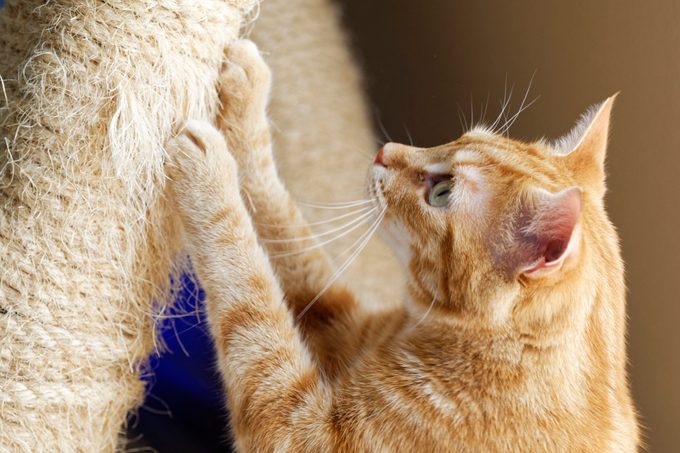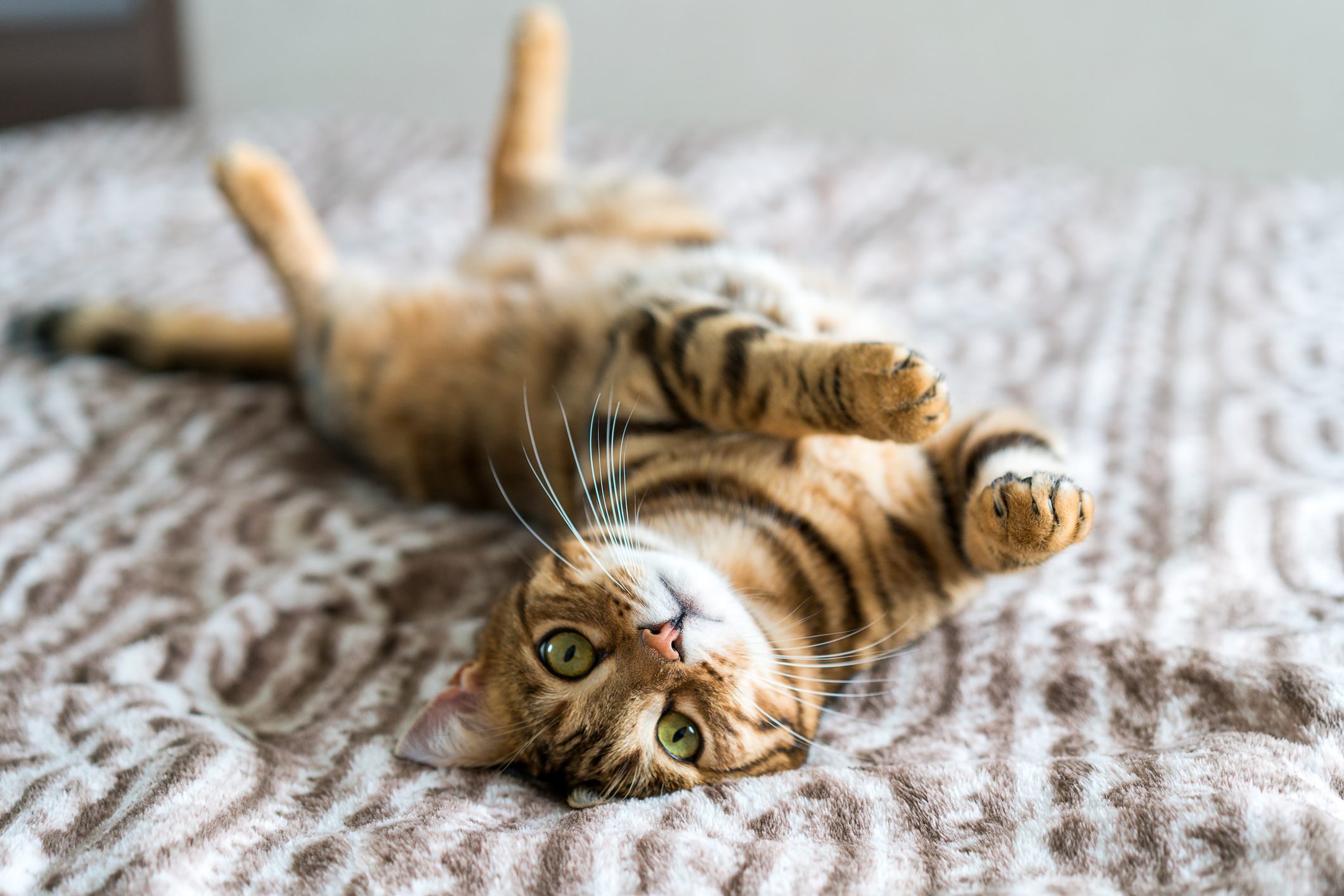Thinking about cat declawing to save your furniture from your feisty kitten? Here’s what you need to know first.

How Safe Is Cat Declawing—And What Are Your Other Options?

If you’ve ever come home to a shredded sofa or watched your cat turn your curtains into their personal jungle gym, you’re not alone. Scratching is completely natural for cats, and they don’t do it because they’re mad at you. It helps them stretch, mark territory and shed old claw sheaths. But when expensive furniture pays the price, some pet parents start considering cat declawing as a fix.
While that may sound like a logical solution, it’s not always the best move for your cat. In fact, many animal welfare groups—including the American Society for the Prevention of Cruelty to Animals (ASPCA) and the American Veterinary Medical Association (AVMA)—discourage declawing and suggest nonsurgical alternatives. To understand the pros and cons of cat declawing, we spoke to veterinarian Jamie Richardson, BVetMed, the chief medical officer at Small Door Veterinary in New York City, and Samantha Canup, DVM, a veterinarian with Noble Creatures Veterinary Services in Washington, Georgia.
Read on to learn about special circumstances that may warrant a cat-declawing procedure and get a guide to safer alternatives so you and your kitty can have a happier relationship.
Get Reader’s Digest’s Read Up newsletter for more pets, tech, travel, cleaning, humor and fun facts all week long.
What is cat declawing?
Also known as onychectomy, declawing is a type of surgery that prevents cats from using their claws to scratch household items or hurt others during rough play. “Declawing a cat is the surgical process of removing/amputating the first ‘knuckle’ of a cat’s toes, thereby removing where the claw grows,” says Dr. Richardson. It’s similar to cutting off a human’s fingers or toes at the top joint.
The procedure is performed under general anesthesia, and the cost varies depending on the nature of the technique, surgical time and the location of the clinic. For uncomplicated cases, the recovery time is around 10 to 14 days. “Cats that have undergone a full declaw will be tender on their paws for several weeks and possibly permanently due to the altered anatomy of the paw,” Dr. Richardson notes.
What are the effects of cat declawing?
The biggest consequence of cat declawing is chronic pain. And this could last the cat’s entire lifetime and result in a change in gait.
“Cats are very good at hiding signs of pain and discomfort, so they can be uncomfortable for many years without you knowing,” Dr. Richardson explains. “It’s important to monitor mobility for changes in gait or obvious signs of discomfort, as declawed cats may be more prone to degenerative joint disease and arthritis as they age, due to the change in the way they must bear weight on the paws after this procedure.”
Beyond that, declawing leaves cats without the ability to do catlike things: When they can’t scratch, cats can have a hard time stretching their muscles and tendons, preventing them from staying healthy. And without claws, they’re less able to hop a fence, climb to get away from a predator or defend themselves against any aggressive cats or other animals they meet outdoors.
That’s why declawed cats must be indoor cats. “Removing the claws removes a cat’s ability to climb trees and jump fences, etc., to evade predators, and they would be very vulnerable if allowed outside,” Dr. Richardson says.
All in all, cat declawing removes a part of what makes your cat a cat—and simply because it makes life easier for you. “[It] irreversibly physically alters a cat for the purposes of changing its natural behavior,” says Dr. Richardson, “most often performed for the convenience of the pet owner.”
Is cat declawing ever necessary?

Declawing is often done to prevent cats from scratching their owners, other animals or furniture—but it should be considered only as a last resort. The AVMA states that declawing can be considered “when a cat’s excessive or inappropriate scratching behavior causes an unacceptable risk of injury or remains destructive despite conscientious attention to behavioral modification and alternatives.”
Ultimately, the decision to declaw the cat is up to the pet owner in conjunction with their vet (assuming it’s legal in the place they live). Some veterinarians are open to declawing if it means the cat doesn’t end up back at the shelter or out on the streets. Dr. Canup recommends the procedure “if it ensures the cat will have a home for the rest of its life. It is better than being outside and at risk for trauma or disease.”
But she emphasizes that it is not for every cat and urges owners who choose this option “to commit to having the pet indoors for the remainder of its life or to finding it an appropriate home if they can no longer care for it.” After all, declawing takes away a cat’s ability to fully defend itself, so letting it outdoors is a major no-no.
On the other hand, Dr. Richardson, whose practice is in New York City, where declawing is illegal, says it should be done only if medically necessary—if there’s an infection of the bone or toe that cannot be resolved medically or if there’s cancer, for example. “In the vast majority of such cases, only one or two digits would require amputation, rather than all of the toes.”
Is there an alternative to cat declawing?
Tendonectomy is a new medical alternative to declawing. Dr. Richardson explains that it involves “small incisions made behind the claw to snip the tendons that are responsible for a cat being able to properly extend its claw.”
While a tendonectomy keeps the claws intact, it’s not a perfect solution. Without the tendons, the toes tend to curl around and alter the cat’s normal anatomy, which predisposes them to arthritis. Dr. Richardson warns that there also is a risk of the curled claws puncturing the pads and causing pain and infection if the nails are not kept meticulously trimmed.
What are some safer alternatives?
Declawing is a life-altering surgery for cats; many veterinarians consider the procedure to be unethical and unnecessary, and they encourage cat owners to opt for safer alternatives to prevent cats from scratching undesirable surfaces. These include:
-
Nail trimming. Trim your cat’s nails every two to three weeks. If it’s challenging for you to do it yourself, bring the cat to a clinic or pet groomer to have it done properly.
-
Nail caps. Gluing blunt nail caps to the cat’s claws can prevent damage from sharp claws. These plastic caps need to be replaced when the nails grow out (every four to six weeks). If you are unable to apply the caps, professional groomers can help.
-
Training. To change your cat’s natural behavioral patterns, provide training at a young age. Encourage your kitten to use a scratching post rather than your sofa by spraying it with pheromone solutions or rubbing it with catnip. Reward your feline with her favorite treats whenever she uses the post.
What to do if your cats love to scratch?

Keeping a cat from scratching the furniture can seem like a Herculean task, but it’s not one that cannot be achieved. Pet owners can try to make changes to the indoor environment and safeguard furniture in the home to avoid the destructive impacts of their cat’s behavior. Here are some things to try:
- Create a stimulating environment: Provide your cat with a stimulating and enriching environment that includes scratching posts and climbing gyms. The post needs to be at least as tall as the cat’s length for her to enjoy a good stretch and drag her claws down. Dr. Richardson suggests experimenting with different types of posts, from traditional posts to corrugated cardboard ramps, to find the one your cat likes best.
- Investing in cat-proof furniture: Because cats love to scratch upholstered surfaces, cat lovers could go for cat-proof couches and chairs made of leather or microfiber. With a tighter weave than other fabric styles, these make it hard for cats to dig in to with their nails. Use plastic, aluminum foil or double-sided tape coverings to deter your cat while you’re in the training phase.
Cat declawing might seem like a quick fix for those shredded couch cushions, but the truth is it can cause more harm than good. The good news? With a little patience and the right cat-training tricks, you can minimize scratching habits and keep both your cat and your gorgeous midcentury couch happy.
About the experts
|
Why trust us
At Reader’s Digest, we’re committed to producing high-quality content by writers with expertise and experience in their field in consultation with relevant, qualified experts. We rely on reputable primary sources, including government and professional organizations and academic institutions as well as our writers’ personal experiences where appropriate. We verify all facts and data, back them with credible sourcing and revisit them over time to ensure they remain accurate and up to date. Read more about our team, our contributors and our editorial policies.
Sources:
- Jamie Richardson, BVetMed, chief medical officer at Small Door Veterinary in New York City
- Samantha Canup, DVM, veterinarian at Noble Creatures Veterinary Services in Washington, Georgia
- ASPCA: “Destructive Scratching”
- AVMA: “Alternatives to declawing”





















